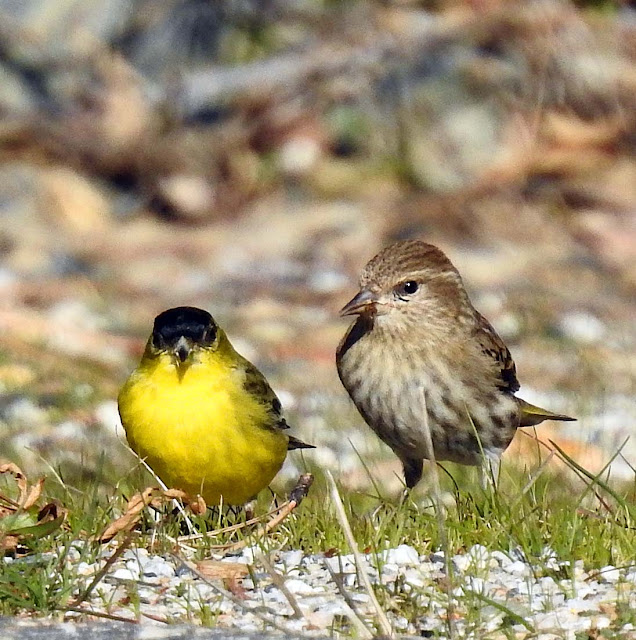In the winter our neighborhood is filled with greens! The river is an incredible, crystal clear, jade-to-apple green color. The moss, ferns, liverworts, and lichens are flourishing in the damp, filling the shaded forest and roadside bluffs with a multitude of greens ranging in color from yellow-to-blue green. It's gorgeous!
Mossicles!
Despite the cold, these plants can grow and flourish in the winter as their cells contain glucose that works like an anti-freeze and keeps the cells from freezing!
Western Polypody Fern - Fern on Mossy rocks - Dendroalsia Moss
Polypodium hesperium - Dendroalsia albietinaOur winter garden!

Common Goldeneye (male) - Bucephala clangula
Neighborhood News!
The Common Goldeneyes are still in residence on our section of the North Yuba River. They are diving ducks and eat fish, aquatic vertebrates, seeds, and tubers. When diving, they keep their wings pressed to their sides underwater, and swim with their webbed feet! They are amazing to watch when they're underwater! Right now the males are in their black and white mating colors, and the females have a yellow tip to their bill. They will migrate to their northern breeding grounds in the boreal forests of northern Canada and Alaska soon!
Red-shouldered Hawk (adult) - Buteo lineatus
I spotted this Red-shouldered Hawk perched along the river's edge this week. What a beauty! As soon as it saw me it took off (see inset photo)! These raptors feed on small mammals and birds at this time of year. Last year I photographed one eating a dead quail!
Lesser Goldfinch (male) - Pine Siskin (female)
Carduelis psaltria - Spinus pinus
To my total delight, there have been flocks of Lesser Goldfinches and Pine Siskins feeding on the ground in our neighborhood this week! I have never seen them together in flocks like this before, but the bird guides say it is common! What a beautiful surprise!
The female Lesser Goldfinches are not as brilliantly yellow as the males, and lack the black forehead and cap. So lovely!
Convergent Ladybird Beetles - Hippodamia convergens
There are still large groups of Convergent Ladybird Beetles in our neighborhood. On one of the warmer, sunny days many of them were flying from the shaded areas to the warm sunny areas! They'll probably stick around for a while, before they head down to lower elevations for the spring.
American Robin (female) - Turdus migratorius
Just this week a few American Robins showed up! They are almost always the earliest migratory songbirds to land in our neighborhood. Some of them will stay and raise their young here.
Gray Fox - Urocyon cinereoargenteus
We spotted this Gray Fox in another part of our neighborhood one afternoon. I'm not sure how many live here, but I would imagine probably no more than ten in the immediate area. It's always a delight to see them!
Alder and Willow in bud
Alnus incana - Salix sp.
Almost all of the local shrubs are in bud, just waiting for the temperatures to warm up before they blossom. Some of the willows have just a tiny bit of their fuzzy blossoms showing.
Greenleaf Manzanita - Whiteleaf Manzanita
Arctostaphylos patula - Arctostaphylos viscida
The local Manzanitas are also still in tight bud. These buds were formed back in the Fall, and will remain closed-up until Spring. Most of the local trees and shrubs contain glucose in their cells that keep them from freezing in the winter, just like the damp mosses, lichens, ferns etc.
Lately I've been visiting the three ponds that I always check on in the winter. I'm happy to report that there are waterfowl on all on of them! Some of them will migrate to higher elevations in the Spring, while some will stay and nest. All three ponds have different residents!
Bufflehead - Bucephala albeola
Right now there is one pair of Bufflehead ducks at Joubert Diggins. More may show up in the near future.
Mallards (female - male) - Anas platyrhynchos
There is also one pair of Mallards, which is the usual population for this pond.
So far I haven't seen any boys in a boat on this pond. I hope it stays that way! Last year they were quite disruptive to the local waterfowl population.
On the day I stopped by, there were three female Hooded Mergansers on the pond! They are so unique with their big "hoods" of feathers!
Hooded Merganser (females) - Lophodytes cucullatus
They will leave soon for their breeding grounds in western Canada! I love seeing them every year!
Wood Duck Pond is lower in elevation so I usually see different waterfowl in this pond, compared to the other two ponds I visit.
Wood Ducks (male - female) - Aix sponsa
On Wood Duck Pond, there were three pairs of Wood Duck!! Yay! I think the male's coloring is astonishing, especially his brilliant red eyes! The females look Egyptian to me, with the white oval around their eyes. It's always such a thrill to see these beautiful ducks!
Sierra Buttes from Sierra City - 2/9/23
I finally went up to the Lakes Basin last week and walked on the snow up to Sardine Lake! I stopped in Sierra City on the way, and took this photo of the Buttes!
Sardine Lake - 2/9/23
Sardine Lake and Sand Pond were both still totally frozen and beautiful! We lingered as long as we could enjoying the gorgeous view. It was so nice to spend the day in the Lakes Basin. More snow is predicted for this coming week! Yay! Winter needs to last at least another month!
What's happening in the foothills and Central Valley?
Is anything blooming?
Check back next week for the answers to these questions and more!
Unfortunately, you can no longer sign up to get my blog via email. Just go to northyubanaturalist.blogspot.com directly.
Your questions and comments are greatly appreciated. Please feel free to email me at northyubanaturalist@gmail.com. Thanks!






















No comments:
Post a Comment